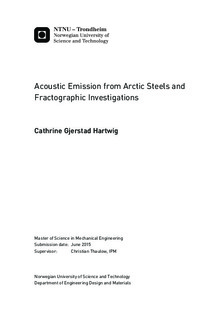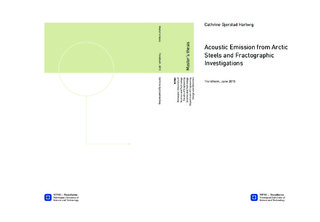| dc.description.abstract | There is a need for better understanding of brittle fracture due to an increased interest in exploring the undiscovered hydrocarbon resources in the arctic region. There is also a need for development of steels with better low temperature fracture toughness, as steels are experiencing a drastic decrease in toughness in the HAZ after welding.
This thesis uses acoustic emission in the investigation of the brittle initiation and propagation micromechanisms for a low carbon HSLA steel. Acoustic emission is emitted when a microcrack nucleates, and by monitoring this, it is possible to investigate the crack nucleation rate during loading. Resent research has also demonstrated that the amplitude of the AE signal can be linked to the size of the arrested microcrack. This can be measures using AE monitoring in fracture mechanic testing, by interrupting the loading when the first AE signal is emitted, and then study the fracture surface in SEM.
The work carried out in this thesis covers microstructural analysis and fracture surface investigation in SEM of interrupted fracture mechanic tested samples and samples run to final fracture. The testing is conducted on the HAZ of the steel at low temperatures. The fracture mechanic testing with AE monitoring is conducted by SINTEF, while this thesis uses the results in the discussion of the brittle micromechanisms.
The results indicate that the steel investigated is mostly nucleation controlled in the HAZ, i.e. after a microcrack initiate there is not many obstacles for crack propagation. The crack initiation mechanism seems to be from inclusions induced to a local stress and strain concentration. Perhaps a few large martensite-austenite (M-A) constituents also initiates fracture. These are commonly formed in the HAZ and is regarded as one of the main reasons for the loss of toughness in the HAZ. The low carbon content in the steel seemed to have reduced the amount of large M-A constituents drastically.
The inclusions are widely scattered which are believed to be the reason for the scatter in fracture toughness obtained from testing. The fracture toughness is also lower than what would be expected with the reduction of M-A constituents. The reason for this are assumed to be due to low crack propagation resistance, associated with coarse upper bainite and large prior austenite grains found in the HAZ through microstructural investigation.
There was limited result regarding microcrack arrest (and initiation) due to the samples only emitting a few AE signals during testing. Only one sample had an arrested microcrack that could be linked to the AE signal. It is therefore need for more research on the relation between the size of the arrested microcrack and the AE signal amplitude. It beneficial that this is conducted on a steel that has better propagation resistance than the steel investigated in this thesis. For monitoring microcrack nucleation on samples running to final fracture, AE is a useful tool. | |

